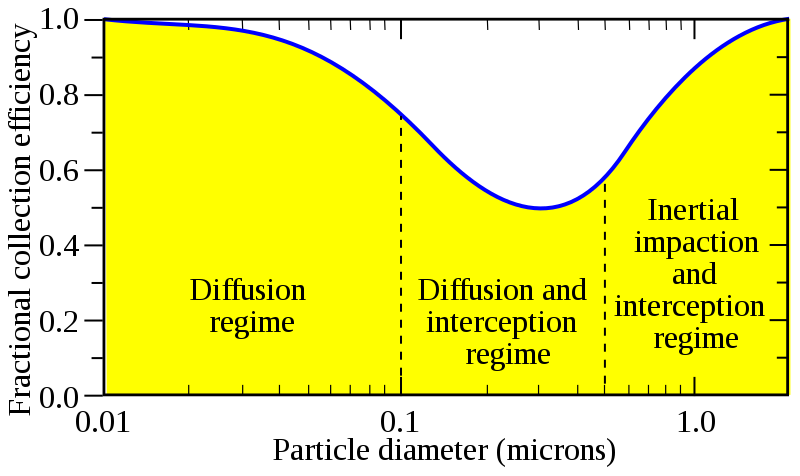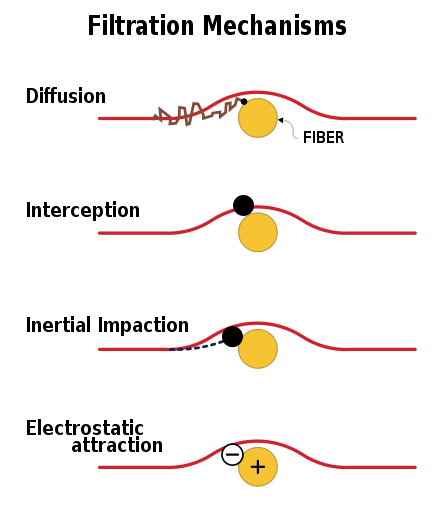NASA
It turns out that our friends and NASA have already done a bunch of work on how to keep air clean.
NASA Technical Memorandum 20170005166
This technical memorandum explains in fairly basic terms how particulate filtering works. There is some maths but to be honest you can skip the maths and just read the explanations.
One particle size to rule them all
The following curve is very important because it helps us understand why 0.3µm was chosen as the most important particle size when filtering air.
The dip in efficiency of collection happens around 0.3µm so it is at these sizes where the filter is at it’s least efficient. This is important because it means if you have a highly effective filter around the 0.3µm range then anything larger and smaller than that particle size is going to find it very difficult to pass though the filter.
This is why the HEPA standard is in part defined in terms of this particle size.
 Collection Efficiency Curve
Collection Efficiency Curve
Filter Collection Mechanisms
The main points to note in the following image is that there’s a lot more going on in a filter than particles impacting against some fibers and being trapped. Diffusion alone is creating an environment where the smaller particles sizes below 0.3µm are being bounced around as they travel through the filter which increases the chance that those particles get trapped. This is why NASA found that at lower air velocity the filter efficiency went up because diffusion meant that the longer the particles took to get through the filter the higher the odds they get trapped.
 Four primary filter collection mechanisms
Four primary filter collection mechanisms
NASA Findings
NASA was using HEPA filter
NASA was using a HEPA filter with a bed of activated carbon. The reason I’m mentioning this is so no one thinks they were using a 1 inch furnace filter :). The mechanisms of filtering is the same in the high quality furnace filters but they’re not HEPA filters.
HEPA vs Active Carbon Bed
The HEPA filter was the most important piece of equipment compared to the active carbon bed for reducing particulate matter from the air.
When used alone, HEPA-rated media provides superior performance for removing
virtually 100% of particulates.
The carbon bed was not the major contributor to particulate removal it was the HEPA filter.
Lower Pressure improves Particulate filtering
As a rule of thumb, reducing the velocity by half not only reduces the pressure drop by half but also decreases particle penetration through the filter media by nearly an order of magnitude. This is illustrated in figure 4 where decreasing the velocity by three-fourths reduces the particle penetration over three orders of magnitude with a corresponding efficiency increase from 99.998% to 99.99998%. In other words, a simple HEPA-rated filter will perform as an ULPA rated or better filter by simply lowering the flow velocity through the media.
This is quite a finding, basically reducing the velocity of the air passing through the filter in half increases the efficiency by 10x, this is amazing.
The reason this happens is due to diffusion. As the particles are passing through the filter they’re being bounced around at random in a similar fashion to Brownian Motion. This random bouncing around means that as the particle spends more time trying to pass through the filter it’s chances of getting trapped go up. The chance of getting trapped are in an inverse relationship with the velocity of the air passing through the filter. So if we decrease the rate at which the fan is running we increase it’s efficiency. There’s an obvious trade off here because if we decrease the velocity to 0 does this mean our filter is 100% efficient? There is likely a sweet spot for the velocity of the air and the type of filter being used and I’d imagine it differs for every media type used in the filter. The point we can take away from this though is that we don’t need a massively powerful fan to achieve great results. As long as the CFM is large enough to pass the air through the filter often enough in an acceptable time frame then we have an effective air filtration system.
What can we learn from the NASA paper.
The main thing I’d like to get across is that a high quality furnace filter will be using the same mechanisms to filter air as a HEPA or a ULPA filter it just won’t be doing it as effectively. This doesn’t mean it’s not useful. On the contrary a good furnace filter attached to a box fan can achieve amazing results.
You can actually see an interesting design called a Corsi-Rosenthal-Box which has been proved to be more effective at filtering air than a lot of commercial filters available on the market. I built a Corsi-Rosenthal-Box but I found it too large and unwieldy in the house so I gave up on it. I also built a triangular model at one point but same problem, it was just a PITA to move around and store and a lot more effort to build.
